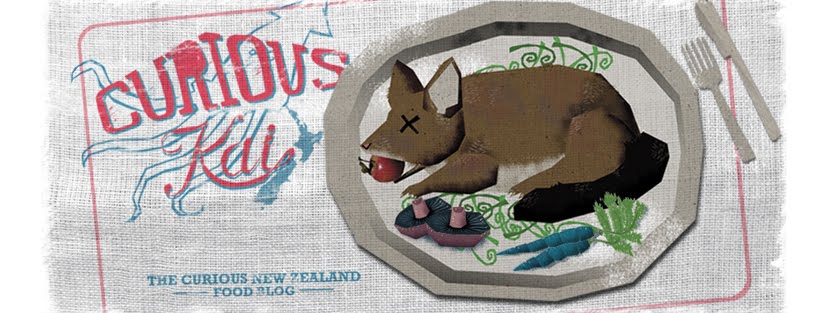Walnuts are truly amazing. The wood from their grand trees have provided furniture for nanas' the world over; the shells of the nut are tough and strong, finding use in heavy industry, as well as in battle (predominantly playground-oriented). And then there's the nut itself, found gracing all manner of food, whether it be cakes or cheeseboards, ice creams and tarts, pastes, oils, sauces and preserves. Walnuts have a uniqueness of flavour which see them working harmoniously with apples, pears, prunes and honey; they also sit quite comfortably with cumin and anise.
Pickled walnuts are a bit of a rarity in New Zealand. An age-old British practice, walnuts are pickled first by immersing the immature, green-husked nut in brine and then flavored by placing in spiced vinegar for several months. When ready, the now blackened husk is removed revealing the flavoursome baby walnut, which is then eaten with cold meats and cheeses.
The ideal time for picking walnuts for preserving is early to mid-summer. With three large, old trees within 100 metres of where I presently write, begging to be plundered, it seemed an ideal opportunity to launch myself into a new project. Not knowing where to start, I was fortunate enough to have in my possession a recipe passed down from generation to generation from the internet (a big thank you to the awesome Cottage Smallholder, a British site that's an absolute mine of information, particularly for those interested in self sufficiency). Time to get the ball rolling.
This wonderful fragrance was overwhelmed rather quickly by the odour of fear emanating from my tremulous self. God knows how many feet up in the air I was, but it was high and I wasn't keen on lingering. I gingerly crept out along the branches, grabbing walnuts as I went, slipping them into my pack. With it rapidly filling, I began to ease myself back towards the trunk and found my way back down.
Having completed the hardest part of the job, and having duly changed my trousers, it was now time to commence with the fiddly bits. First, I had to check whether the shell inside the husk had hardened around the nut - if it has, it'll have to be rejected because the spiced vinegar won't be be able to permeate through to the nut to flavour it. To gauge suitability, grab a fork and insert it into the husk at the end opposite where the stalk was. If it slides in unhindered, it's a keeper. Do this to all of your nuts *chortle*
Oh, and put some gloves on before you start. When you jab the husk, it will release a liquid which will stain your fingers, giving them the nicotine-stained appearance of someone who's been smoking since the age of nine. It took a week before it started to fade. You have been warned...
Next, you'll need to brine the walnuts for two weeks. In a bucket, dissolve salt with water at the rate of 150g per litre of water (that's a 5L bucket, above). Once done, add your walnuts. Pop something heavy on top to ensure that all the walnuts are submerged. After seven days, tip out the brine and replace with a fresh mix. Over time, the walnuts will turn from green to a dirty, charcoal-grey.
At the end of two weeks, tip your walnuts and brine into the sink. Rinse the walnuts in cold water, dry with a towel and place on a tray lined with baking or greaseproof paper. Once exposed to air, they will rapidly turn black. Turn them to ensure all sides are exposed - leave for three days.
Now for the spiced vinegar, which serves as both preservative and flavouring agent. Here, I leave it up to you as to how you'll flavour your vinegar. The most common recipes I've found online and in books seem to have malt vinegar with cloves, mustard, peppercorns and allspice. Fiona at Cottage Smallholder has several variations, some using white wine vinegar, tarragon, mace and garlic. I used malt vinegar with dried chillies, coriander seeds, peppercorns, cloves, brown sugar and a bayleaf. Ratios are roughly 1.5 teaspoons of dried spice and 3 tablespoons of whole spice (this covers sugar, too) per 1.5L of vinegar. It's not gospel though; again, feel free to use whatever you like in whatever proportion you see fit.
Bring all your ingredients to the boil, then reduce to a very gentle simmer for about an hour. Place your walnuts in sterilised jars, then pour over your spiced vinegar. Seal and leave in a cool, dark place for at least three months. These will be ready just as winter takes up residence here - I'll bring you pictures then and we'll see how they taste...



















7 comments:
A big thank you to Helen & Rob for letting me raid their tree!
I don't think I've ever had pickled walnuts - can't wait to see how these turn out!
and I don't know if I'd be as brave as you in climbing the tree to pick them ;)
What a commitment of a recipe! Suspect my treeclimbing days are over but I do love the anticipation and observation that goes into this process. Am lucky enough to have a bag of fully-formed walnuts, a gift from home, to use up in my cooking and baking :)
MM - If I fell out of that tree, I would have rolled down a very steep hill & landed in one of Napier's major thoroughfares!
H&F - After all this effort, they better taste good... Actually, I picked up a jar of pickled walnuts from Waitrose, but I haven't gotten round to opening them - I'll do it soon & see what they're like.
Another great effort Nigel, quite disturbed by your amusement from stabbing your nuts
Cheers, Barton :)
Post a Comment